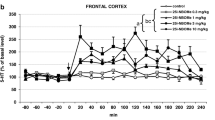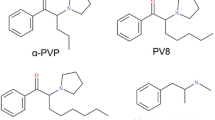Abstract
When administered i.p. from doses of 10 mg/kg, RU 23686 [5-methoxy 3-(4-piperidinyl) 1H-indole hydrochloride], a drug with relatively weak stimulant properties, induces contralateral (C) circling behaviour in rats with a unilateral electrolytic lesion in the striatum and a more complex effect with ipsilateral (1) and/or C circling in rats with a 6-hydroxydopamine (6-OHDA) lesion in the dopamine (DA) nigro-striatal tract. Interactions of RU 23686 with pharmacological agents have been studied in order to investigate the extent to which different neurotransmitters may be implicated in the circling behaviour induced by this compound.
In striatal of 6-OHDA lesioned rats, α methyl p-tyrosine (αMT) did not modify C turns, while in the latter case only I turns were decreased. FLA 63, propranolol, and desipramine were also inactive in rats with a unilateral striatal lesion. Haloperidol reduced the effects of a 10 mg/kg dose of RU 23686 in striatal lesioned rats but was without effect against a dose of 20 mg/kg; in 6-OHDA lesioned rats, haloperidol blocked induced I turns but either did not affect or increased C turns. Phenoxybenzamine and p-chlorophenylalanine (PCPA), but not methysergide, p-chloroamphetamine (PCA), or fluoxetine, reduced the effect of RU 23686 in rats with a striatal lesion. In nigro-striatal lesioned rats, PCPA exhibited a differing effect according to the predominance of I or C turns: in rats with a mainly C response, C turns were decreased and I turns preserved, whereas in rats with a majority of I responses, these were depressed. In both types of lesions, animals reserpinized 48 h before RU 23686 exhibited an increase in their C circling, even in 6-OHDA lesioned animals where I turns predominated. In both rotational models, apomorphine-induced circling was potentiated by RU 23686.
It is concluded that I circling, which is blocked by haloperidol and αMT, could be related to a presynaptic action causing DA release. On the other hand, C turns do not depend on apomorphine-sensitive DA receptors in the striatum. A minor or indirect role of 5-hydroxytryptamine (5-HT) containing areas is suggested from the response to PCPA and the lack of effect of other drugs interfering with 5-HT. Results obtained from interactions with phenoxybenzamine, caffeine, and reserpine and the bimodal response to RU 23686 observed in 6-OHDA lesioned rats could indicate an interference with adrenergic processes.
Similar content being viewed by others
References
Andén, N.-E., Dahlström, A., Fuxe, K., Larsson, K.: Functional role of the nigro-neostriatal dopamine neurons. Acta Pharmacol. Toxicol. (Kbh.) 24, 263–274 (1966)
Andén, N.-E., Strömbom, U.: Adrenergic receptor blocking agents: effects on central noradrenaline and dopamine receptors and on motor activity. Psychopharmacologia (Berl.) 38, 91–103 (1974)
Baldessarini, R. J., Amatruda, T. T., Griffith, F. F., Gerson, S.: Differential effect of serotonin on turning and stereotypy induced by apomorphine. Brain Res. 93, 158–163 (1975)
Baum, E., North-Diehl, A. Piarroux, M.-C., Thenint, F., Boissier, J.-R.: Modifications biochimiques, histochimiques et pharmacologiques après lésion bilatérale des différentes parties de la substance noire chez le Rat. J. Pharmacol. (Paris) 3, 477–486 (1972)
Boissier, J.-R., Dumont, C., Oberlander, C., Peterfalvi, M.: A comparison of circling behaviour induced in nigro-striatal lesioned rats after peripheral administration of indole derivatives. Proceedings of the British Pharmacological Society, 15th–17th September 1976. Br. J. Pharmacol. 58, 452 (1976)
Corrodi, H., Fuxe, K., Lidbrink, P.: Interaction between cholinergic and catecholaminergic neurones in rat brain. Brain Res. 43, 397–416 (1972)
Costall, B., Kelly, D. M., Naylor, R. J.: Nomifensine: a potent dopaminergic agonist of antiparkinson potential. Psychopharmacologia (Berl.) 41, 153–164 (1975)
Costall, B., Naylor, R. J.: Stereotyped and circling behaviour induced by dopaminergic agonists after lesions of the midbrain raphé nuclei. Eur. J. Pharmacol. 29, 206–222 (1974)
Costall, B., Naylor, R. J.: The role of the raphé and extrapyramidal nuclei in the stereotyped and circling responses to quipazine. J. Pharm. Pharmacol. 27, 368–371 (1975)
Fuxe, K., Agnati, L. F., Ungerstedt, U.: The effect of mepiprazole on central monoamine neurons. Evidence for increased 5-hydroxytryptamine and dopamine receptor activity. Eur. J. Pharmacol. 35, 93–108 (1976)
Fuxe, K., Ungerstedt, U.: Action of caffeine and theophyllamine on supersensitive dopamine receptors: considerable enhancement of receptor response to treatment with Dopa and dopamine receptor agonists. Med. Biol 52, 48–54 (1976)
Goetz, C., Klawans, L.: Studies on the interaction of reserpine, d-amphetamine, apomorphine and 5-hydroxytryptophan. Acta Pharmacol. Toxicol. (Kbh.) 34, 119–130 (1974)
Green, A. R., Youdim, M. B. H., Grahame-Smith, D. G.: Quipazine: its effects on rat brain 5-hydroxytryptamine metabolism, monoamine oxidase activity and behaviour. Neuropharmacology 15, 173–179 (1976)
Guilleux, H., Peterfalvi, M.: Le comportement de rotation après lésion unilatérale du striatum analysé à l'aide d'un rotomètre. J. Pharmacol. (Paris) 5, 63–74 (1974)
Haigler, H. J., Aghajanian, G. K.: Peripheral serotonin antagonists: failure to antagonize serotonin in brain areas receiving a prominent serotoninergic input. J. Neurol. Transm. 35, 257–273 (1974)
Horn, A. S., Phillipson, O. T.: A noradrenaline sensitive adenylate cyclase in the rat limbic forebrain: preparation, properties and the effects of agonists, adrenolytics and neuroleptic drugs. Eur. J. Pharmacol. 37, 1–11 (1976)
Kebabian, J. W., Petzold, G. L., Greengard, P.: Dopamine sensitive adenylate cyclase in caudate nucleus of rat brain, and its similarity to the “dopamine receptor.” Proc. Natl. Acad. Sci. USA 69, 2145–2149 (1972)
König, J. F., Klippel, R. A.: The rat brain. A stereotaxic atlas of the forebrain and lower parts of the brain stem. Baltimore: Williams and Wilkins 1963
Meek, J. L., Bertilsson, L.: Comparison of the effects of lesion in the “B9” cell body group and p-chloroamphetamine on tryptophan hydroxylase and 5-hydroxytryptamine in rat brain nuclei. Brain Res. 100, 140–144 (1975)
Palmer, D. S., French, S. W., Narod, M. L.: Noradrenergic subsensivity and supersensitivity of the cerebral cortex after reserpine treatment. J. Pharmacol. Exp. Ther. 196, 167–171 (1976)
Pieri, L., Pieri, M., Haefely, W.: LSD as an agonist of dopamine receptors in the striatum. Nature 252, 586–588 (1974)
Pycock, C. J., M. G. Donaldson, I. Marsden, C. D.: Circling behaviour produced by unilateral lesions in the region of the locus coeruleus in rats. Brain Res. 97, 317–319 (1975)
Sanders-Bush, E., Bushing, J. A., Sulser, F.: Long term effects of p-chloroamphetamine and related drugs on central serotoninergic mechanisms. J. Pharmacol. Exp. Ther. 192, 33–41 (1975)
Ungerstedt, U.: Stereotaxic mapping of the monoamine pathways in the rat brain. Acta Physiol. Scand. [Suppl.] 367, 1–47 (1971a)
Ungerstedt, U.: Striatal dopamine release after amphetamine or nerve degeneration revealed by rotational behaviour. Acta Physiol. Scand. [Suppl.] 367, 49–68 (1971b)
Wong, D. T., Bymaster, F. P., Horng, J. S., Molloy, B. B.: 3-(p-trifluoromethylphenoxy)-N-methyl-3-phenylpropylamine (Lilly 110140), a specific inhibitor of serotonin uptake into synaptosomes of rat brain. Fed. Proc. 33, 255 (1974)
Author information
Authors and Affiliations
Rights and permissions
About this article
Cite this article
Boissier, J.R., Oberlander, C., Dumont, C. et al. Pharmacological interactions with circling behaviour induced by the piperidinyl indole derivative RU 23686. Psychopharmacology 55, 53–60 (1977). https://doi.org/10.1007/BF00432817
Received:
Accepted:
Issue Date:
DOI: https://doi.org/10.1007/BF00432817




